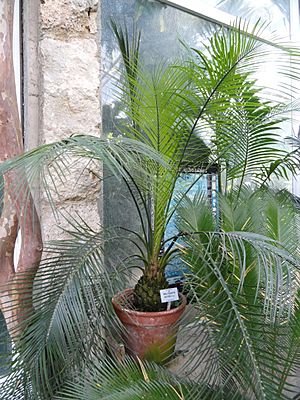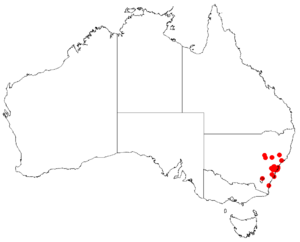Macrozamia spiralis facts for kids
Quick facts for kids Macrozamia spiralis |
|
|---|---|
 |
|
| Macrozamia spiralis specimen in the Botanischer Garten München-Nymphenburg, Munich, Germany | |
| Conservation status | |
| Scientific classification | |
| Genus: |
Macrozamia
|
| Species: |
spiralis
|
 |
|
| Occurrence data from AVH | |
| Synonyms | |
The Macrozamia spiralis is a unique type of plant called a cycad. It belongs to the Zamiaceae family. This plant is special because it grows only in New South Wales, which is in eastern Australia. You can find it in forests where the soil doesn't have many nutrients. These plants usually don't have a tall trunk. Instead, they have 2 to 12 leaves that can grow up to 100 cm (40 in) long.
Contents
What is a Macrozamia Spiralis?
This cycad usually doesn't have a stem that grows above the ground. Its stem stays mostly hidden, about 8–20 cm (3.2–8 in) wide. Each plant has 2 to 12 leaves, also called fronds. These fronds can be anywhere from 35 to 100 cm (14–40 in) long.
Each frond is made up of many smaller leaf parts, called pinnae. There are about 45 to 120 of these on each frond. They are 12–20 cm (4.5–8 in) long and about 0.5–1 cm (0.2–0.4 in) wide. Sometimes, the main stem of the leaf can be twisted, like a spiral!
Reproduction and Life Cycle
Macrozamia spiralis plants have separate male and female parts. A male plant grows 1 to 4 pollen-bearing cones. These cones are shaped like a spindle and are about 15–20 cm (6–8 in) tall.
A female plant produces a single oval-shaped seed cone. This cone is 12–20 cm (4.5–8 in) tall. The seeds inside are orange to red and are usually ready in April and May.
These plants grow slowly. They don't start making seeds until they are 10 to 20 years old. Scientists believe they can live for over 60 years! If there's a bushfire, these tough plants can regrow from the ground.
Special Roots
Young Macrozamia spiralis plants have special roots. They have a tuber (a swollen underground stem) and unique roots called coralloid roots. These coralloid roots grow above the ground. Inside them live tiny living things called cyanobacteria.
These cyanobacteria help the plant by taking nitrogen from the air and turning it into food for the plant. This is a helpful partnership, where both the plant and the cyanobacteria benefit. Scientists have found that different types of cyanobacteria, like Nostoc, can live in these cycad roots.
Where Macrozamia Spiralis Lives
You can find Macrozamia spiralis in central New South Wales, Australia. Its home stretches from Dunedoo and the Goulburn River valley, east over the Blue Mountains, and into the Sydney Basin. It grows south to Waterfall and Wallacia, and north to Maroota and Putty.
This plant is protected in several nature areas. These include Werakata National Park, Windsor Downs Nature Reserve, Agnes Banks Nature Reserve, and Castlereagh Nature Reserve. It grows in forests on clay, sandy, or gravelly soils that don't have many nutrients. You might see it growing under trees like the narrow-leaved apple (Angophora bakeri) or the broad-leaved red ironbark (Eucalyptus fibrosa).
Sadly, in 2003, Macrozamia spiralis was listed as an endangered species. This means it needs our help to survive.
Growing Macrozamia Spiralis
If you want to grow Macrozamia spiralis, you can plant it in a pot or directly in the ground. It needs soil that drains water well. It also likes extra water when it's dry. You can even grow it under other trees.
You can start new plants from seeds. But be patient! It can take 12 to 18 months for the seeds to sprout.
Uses of the Plant
In the past, people used parts of the Macrozamia spiralis plant for different things. They used it to make alcohol, sticky pastes, and even laundry starch.


